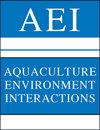法国地中海普雷沃斯特泻湖因海鲷捕食而造成的养殖双壳类损失
IF 2.5
2区 农林科学
Q2 FISHERIES
引用次数: 4
摘要
在世界范围内都观察到海鲷捕食双壳类动物的现象,这是双壳类养殖者主要关注的问题。必须更好地了解养殖双壳类与海洋生物的相互作用,以确保双壳类水产养殖的可持续性。本研究的目的是利用声波遥测技术表征Prevost泻湖(地中海)双壳类养殖场中金头海鲷(Sparus aurata)的存在,并在养殖场内和无保护的实验平台上评估18个月期间由于海鲷捕食而导致的贻贝(Mytilus galloprovincialis)和牡蛎(crasstrea gigas)的月损失。在双壳类养殖场中,大(281 ~ 499 mm TL)的海鲷比小(200 ~ 280 mm TL)的海鲷更常见。与小型海目相比,90%的大型海目在第二年返回并在研究区域停留较长时间,这表明以双壳类养殖场为觅食场所的大型鱼类的年间地点保真度。在无保护的实验平台上,贻贝和牡蛎全年都有被捕食的迹象。农民们注意到从4月到9月农场的损失。在牡蛎“粘”和贻贝“嵌套”后,观察到最大损失(90%至100%)。尽管部署了渔网作为机械保护以减少捕食,但牡蛎的损失仍占牡蛎年销售额的28%,而贻贝的损失估计约为1%。这些结果表明,双壳类动物必须全年都有网保护,以避免捕食,特别是在处理后。贝类养殖户和渔民之间的合作可能是双壳类养殖的可持续解决方案,通过定期在农场、工作台之间和防护网内捕捞海鲷。本文章由计算机程序翻译,如有差异,请以英文原文为准。
Farmed bivalve loss due to seabream predation in the French Mediterranean Prevost Lagoon
Bivalve predation by seabream has been observed worldwide and is a major concern for bivalve farmers. Farmed bivalve-seabream interactions must be better understood to ensure the sustainability of bivalve aquaculture. The objectives of this study were to characterize gilthead seabream Sparus aurata presence in a bivalve farm in Prevost Lagoon (Mediterranean Sea) using acoustic telemetry and to evaluate monthly losses of mussels Mytilus galloprovincialis and oysters Crassostrea gigas due to seabream predation over an 18 mo period inside the farm and at an unprotected experimental platform. Large (281 to 499 mm TL) seabream were more commonly detected in the bivalve farm than were small (200 to 280 mm TL) seabream. In contrast to small seabream, 90% of large seabream returned to and spent extended periods in the study area the following year, suggesting inter-annual site fidelity for large fish that used the bivalve farm as a feeding site. Signs of predation were observed on mussels and oysters throughout the year at the unprotected experimental platform. Farmers noted losses in the farm from April to September. Maximal losses (90 to 100%) were observed post-oyster ‘sticking’ and mussel socking. Despite the deployment of nets as mechanical protection to reduce predation, oyster losses represented 28% of the annual value of oysters sold while mussel losses were estimated at ca. 1%. These results suggest that bivalves must be protected by nets throughout the year to avoid predation, particularly post-handling. A collaboration between shellfish farmers and fishermen could be a sustainable solution for bivalve farming, by regularly fishing for seabream in farms, between tables and inside protective nets.
求助全文
通过发布文献求助,成功后即可免费获取论文全文。
去求助
来源期刊

Aquaculture Environment Interactions
FISHERIES-MARINE & FRESHWATER BIOLOGY
CiteScore
4.90
自引率
13.60%
发文量
15
审稿时长
>12 weeks
期刊介绍:
AEI presents rigorously refereed and carefully selected Research Articles, Reviews and Notes, as well as Comments/Reply Comments (for details see MEPS 228:1), Theme Sections and Opinion Pieces. For details consult the Guidelines for Authors. Papers may be concerned with interactions between aquaculture and the environment from local to ecosystem scales, at all levels of organisation and investigation. Areas covered include:
-Pollution and nutrient inputs; bio-accumulation and impacts of chemical compounds used in aquaculture.
-Effects on benthic and pelagic assemblages or processes that are related to aquaculture activities.
-Interactions of wild fauna (invertebrates, fishes, birds, mammals) with aquaculture activities; genetic impacts on wild populations.
-Parasite and pathogen interactions between farmed and wild stocks.
-Comparisons of the environmental effects of traditional and organic aquaculture.
-Introductions of alien species; escape and intentional releases (seeding) of cultured organisms into the wild.
-Effects of capture-based aquaculture (ranching).
-Interactions of aquaculture installations with biofouling organisms and consequences of biofouling control measures.
-Integrated multi-trophic aquaculture; comparisons of re-circulation and ‘open’ systems.
-Effects of climate change and environmental variability on aquaculture activities.
-Modelling of aquaculture–environment interactions; assessment of carrying capacity.
-Interactions between aquaculture and other industries (e.g. tourism, fisheries, transport).
-Policy and practice of aquaculture regulation directed towards environmental management; site selection, spatial planning, Integrated Coastal Zone Management, and eco-ethics.
 求助内容:
求助内容: 应助结果提醒方式:
应助结果提醒方式:


